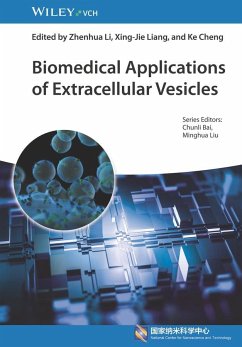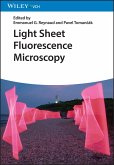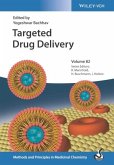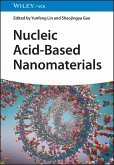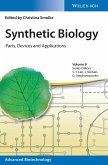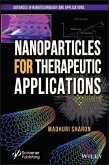Biomedical Applications of Extracellular Vesicles
Herausgegeben:Li, Zhenhua; Liang, Xing-Jie; Cheng, Ke; Bai, Chunli; Liu, Minghua
Biomedical Applications of Extracellular Vesicles
Herausgegeben:Li, Zhenhua; Liang, Xing-Jie; Cheng, Ke; Bai, Chunli; Liu, Minghua
- Gebundenes Buch
- Merkliste
- Auf die Merkliste
- Bewerten Bewerten
- Teilen
- Produkt teilen
- Produkterinnerung
- Produkterinnerung
explains in detail how extracellular vesicles are produced, endocytosed, and the mechanisms by which molecules play biological roles in the treatment of various diseases.
Andere Kunden interessierten sich auch für
![Intracellular Thermometry with Fluorescent Molecular Thermometers Intracellular Thermometry with Fluorescent Molecular Thermometers]() Seiichi UchiyamaIntracellular Thermometry with Fluorescent Molecular Thermometers82,99 €
Seiichi UchiyamaIntracellular Thermometry with Fluorescent Molecular Thermometers82,99 €![Light Sheet Fluorescence Microscopy Light Sheet Fluorescence Microscopy]() Light Sheet Fluorescence Microscopy89,99 €
Light Sheet Fluorescence Microscopy89,99 €![Targeted Drug Delivery Targeted Drug Delivery]() Targeted Drug Delivery159,00 €
Targeted Drug Delivery159,00 €![Nucleic Acid-Based Nanomaterials Nucleic Acid-Based Nanomaterials]() Nucleic Acid-Based Nanomaterials98,99 €
Nucleic Acid-Based Nanomaterials98,99 €![Cellular Imaging Cellular Imaging]() Cellular Imaging129,99 €
Cellular Imaging129,99 €![Synthetic Biology Synthetic Biology]() SmolkeSynthetic Biology184,99 €
SmolkeSynthetic Biology184,99 €![Nanoparticles for Therapeutic Applications Nanoparticles for Therapeutic Applications]() Madhuri SharonNanoparticles for Therapeutic Applications267,99 €
Madhuri SharonNanoparticles for Therapeutic Applications267,99 €-
-
-
explains in detail how extracellular vesicles are produced, endocytosed, and the mechanisms by which molecules play biological roles in the treatment of various diseases.
Produktdetails
- Produktdetails
- Verlag: Wiley-VCH
- Artikelnr. des Verlages: 1135212 000
- 1. Auflage
- Seitenzahl: 208
- Erscheinungstermin: Januar 2024
- Englisch
- Abmessung: 246mm x 171mm x 16mm
- Gewicht: 556g
- ISBN-13: 9783527352128
- ISBN-10: 3527352120
- Artikelnr.: 68270309
- Herstellerkennzeichnung
- Wiley-VCH GmbH
- Boschstraße 12
- 69469 Weinheim
- wiley.buha@zeitfracht.de
- 06201 6060
- Verlag: Wiley-VCH
- Artikelnr. des Verlages: 1135212 000
- 1. Auflage
- Seitenzahl: 208
- Erscheinungstermin: Januar 2024
- Englisch
- Abmessung: 246mm x 171mm x 16mm
- Gewicht: 556g
- ISBN-13: 9783527352128
- ISBN-10: 3527352120
- Artikelnr.: 68270309
- Herstellerkennzeichnung
- Wiley-VCH GmbH
- Boschstraße 12
- 69469 Weinheim
- wiley.buha@zeitfracht.de
- 06201 6060
Dr. Zhenhua Li is the Professor of Southern Medical University, China and his Ph.D. degrees are from Changchun Institute of Applied Chemistry, Chinese Academy of Sciences. His research focus on the design of biomimetic materials for cancer therapy and regenerative medicine. Prof. Zhenhua Li has authored >90 publications including Nature Nanotechnology, Nature Biomedical Engineering, Science Advances, Nature Communications. His works have been cited over 4800 times so far and H-index is 42. He is a guest editor of Frontiers in Cardiovascular Medicine and Chemistry, and an editorial board member of Chinese Chemical Letters and Exploration. Dr. Xing-Jie Liang got his Ph.D at National Key Laboratory of Biomacromolecules, Institute of Biophysics, Chinese Academy of Sciences. He finished his postdoc with Dr. Michael M. Gottesman (Deputy Director of NIH, USA and Academician member of US national academy of sciences) for 5 years at Laboratory of Cell Biology, Center for Cancer Research, National Cancer Institute, National Institutes of Health, Bethesda, Maryland. Then, he worked as a Research Fellow at Surgical Neurology Branch, NINDS (National Institute of Neurological Diseases and Strokes, NIH) for 2 years. In 2007, he was an Assistant professor at Department of Radiology, School of Medicine, Howard University. Dr. Liang currently is deputy director of Key Laboratory for Biomedical Effects of Nanomaterials and Nanosafety, Chinese Academy of Sciences and Lab Chief of Laboratory of Controllable Nanopharmaceuticals, National Center for Nanoscience and Technology of China. He is also leading a group on nanopharmaceuticals at the CAS Center for Excellence in Nanoscience and Chief Lecture Professor of Nanobiology at University of Chinese Academy of Sciences. Ke Cheng is Professor in the Department of Molecular Biomedical Sciences at the College of Veterinary Medicine and Professor in the UNC/NCSU joint Department of Biomedical Engineering. He is also an adjunct professor at the UNC Eshelman School of Pharmacy and UNC School of Medicine. His research focuses on the development of novel nano theranostic agents for regenerative medicine as well as bioengineering approaches to augment stem cell engraftment and potency.
1. Extracellular vesicles and their biomedical applications: An Overview
2. Biogenesis and identification of extracellular vesicles
3. Therapeutic potential of extracellular vesicles from different cell sources
4. Biomedical applications of extracellular vesicles in treatment of disease
5. Applications of engineered extracellular vesicles
6. Current technology for extracellular vesicles production, isolation and quality control
7. Prospects and limitations of clinical application of extracellular vesicles
8. Conclusion and future perspectives
2. Biogenesis and identification of extracellular vesicles
3. Therapeutic potential of extracellular vesicles from different cell sources
4. Biomedical applications of extracellular vesicles in treatment of disease
5. Applications of engineered extracellular vesicles
6. Current technology for extracellular vesicles production, isolation and quality control
7. Prospects and limitations of clinical application of extracellular vesicles
8. Conclusion and future perspectives
1. Extracellular vesicles and their biomedical applications: An Overview
2. Biogenesis and identification of extracellular vesicles
3. Therapeutic potential of extracellular vesicles from different cell sources
4. Biomedical applications of extracellular vesicles in treatment of disease
5. Applications of engineered extracellular vesicles
6. Current technology for extracellular vesicles production, isolation and quality control
7. Prospects and limitations of clinical application of extracellular vesicles
8. Conclusion and future perspectives
2. Biogenesis and identification of extracellular vesicles
3. Therapeutic potential of extracellular vesicles from different cell sources
4. Biomedical applications of extracellular vesicles in treatment of disease
5. Applications of engineered extracellular vesicles
6. Current technology for extracellular vesicles production, isolation and quality control
7. Prospects and limitations of clinical application of extracellular vesicles
8. Conclusion and future perspectives

